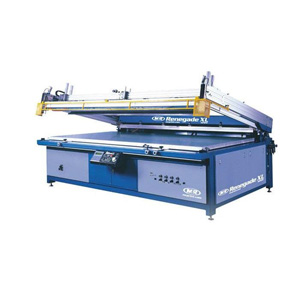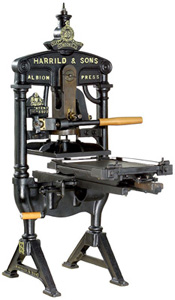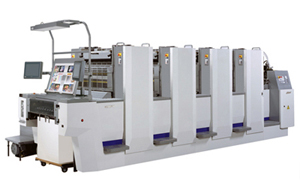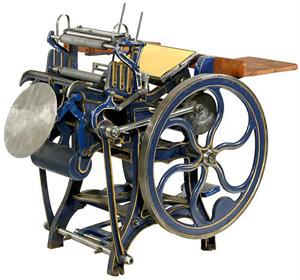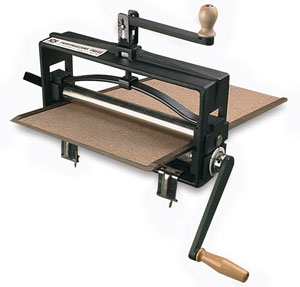Printing Primer: Part 1
A brief look at types of printing, their history and some key terms.
In 2019, the profession of "printer" is no longer listed as an "official job" by the Bureau of Labor Statistics. Why? The Labor Department has determined that the industry has become too small for it to track as a separate category in its database. But this does not mean that the job or profession of being a printer disappeared like the dodo. It just means that on a large scale in commercial printing, jobs have shrunk as more elements of the process, once done by people, have become automated.
Nevertheless, there are still many professional printers on a smaller scale. Over the past 15 to 20 years, thanks in part to the influence of Martha Stewart, there has been a rise of small, artisanal print shops producing printed goods via "old school" printing techniques, especially letterpress. At the same time, these creative printers are breathing new life into the process by embracing digital technology to produce more contemporary-looking, yet still hand-printed, pieces.
At NobleWorks Cards, we've adopted these same techniques because they let us print some of the most hilarious greeting cards and funny birthday cards on the market.
We use all these tricks of the trade to make offbeat greeting cards with eye-catching design, hilarious jokes, beautiful art and lively typography in order to create cards that will be cherished for a lifetime. Those same techniques let us work with aspiring artists to bring their greeting card ideas to life. They also let us react fast to new developments in pop culture, politics or current events.
So what are these "old school" printing techniques that artisan shops are embracing? Here's a brief and somewhat over-simplified introduction to these different types of printing.
Letterpress Printing
Letterpress is said to be the oldest form of traditional printing, and dates back as far as the as the 15th century and Gutenberg. A form of relief printing, letterpress has a raised printing surface that's inked—the paper is placed on the inked surface and the ink is transferred to the paper under pressure from the press. The process results in a slight depression of the type and images in the paper as well as the ink composing them. This gives letterpress-printed pieces the tactile quality that appealed to Martha Stewart so strongly.Originally, letterpress type was handset letter by letter, line by line, to create each printed page. In the early 1890s, typesetting machines sped up the composition process and came into play for commercial use. By the 1980s and the rise of computers and digital technology, letterpress type was no longer manufactured by the major producers. Many commercial printers—especially newspapers—began using photo-sensitive plastic sheets to produce the composed pages. Alternatively, they turned to offset printing.
In recent years, letterpress has become popular for wedding invitations, greeting cards and other stationery items. With an ever-decreasing supply of the no-longer-produced traditional metal and wooden print type and icons (which wear out after continued use), many of today's artisan printers are using their computers to design pieces. This allows them more latitude in typography and creating images that are then turned into photopolymer plastic printing plates. Once the printing plates are produced, the printing process is still the same. Sheets of paper are fed one by one, by hand, through the press.
Offset Printing
Offset is a type of lithography, which is a form of printing on a plane, or flat, surface. The image is neither raised nor sunk, or incised, into the surface. The process is based on the principle that oil and water don't mix. The image or print areas are treated to accept the oil-based ink, while the moisture-based non-print areas repel the ink.Offset printing history is particularly fascinating. Lithography dates back to the turn of the 19th century with a type of porous limestone used as the printing plate surface. The offset process arose in the mid-19th century but was not refined for commercial printing on paper until the beginning of the 20th century. In place of porous limestone, metal plates—usually zinc or aluminum—were developed to create the print surface.
The offset process involves the inked image on the plate first being printed onto a rubber cylinder, which then transfers—or offsets—the image to the paper. Offset printing can produce print runs in large quantities and has become a commercially popular method for printing greeting cards, calendars, newspapers, magazines, billboards, other advertising materials and much more.
Engraved Printing
Engraved printing dates to around the early 16th century and is renowned for its ability to reproduce fine lines and detail. You may have one of the best examples in your wallet right now: United States' banknotes are produced by engraved printing.In engraving, the image or type to be printed is either: (1) cut into a copper or steel plate by hand with a tool called a burin or (2) etched with an acid into the plate. Either method creates recessed "wells" that hold the ink. Paper is then placed on the plate and, under great pressure, the image is printed on the paper, resulting in a slight indentation on the reverse side of the paper.
Engraved printing is especially used for high-quality personal stationery and invitations. The commercial form of engraved printing is known as rotogravure and used for large print runs requiring high-quality reproduction.
Printing Terms:
To help understand some terminology, here are a few key definitions:- Letterpress: Relief printing from raised type or imagery, resulting in the image being slightly impressed into the paper.
- Offset: A form of planographic, or flat plane, printing. The printing image is first printed on a rubber cylinder and then transferred to the paper.
- Engraving: Printing images cut or etched into the printing plate, resulting in a product with ink on a slightly raised surface.
- Platen: The flat plate of a press that is clamped or pressed down on the inked print surface.
- Flatbed Press: Either a Platen press or a press that has a cylinder that rolls over the paper as it passes over the inked print surface.
- Rotary Press aka Web Press: A press where the print surface is wrapped around a cylinder and the paper passes between it and a pressure cylinder.

